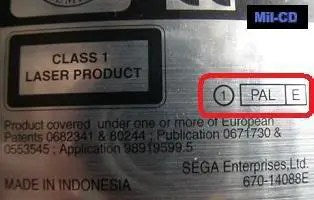How to tell which model dreamcast you have and if it plays MIL CD burned / copied games?
Short answer: VA0 or VA1
In order to play games that have been burned to CD, your Dreamcast must have been made before October 2000. This exploit is know as MIL CD compatible. Newer Dreamcast's have changes made to the way discs are read which prevents backed up games from playing.
On the bottom of the Dreamcast, look for a number in a circle near the word PAL or NTSC. If the number is 0 or 1 you can play burned games. If the number is 2 or higher, you cannot play burned games.
The Japanese models are a little more complex and they do not have the circled numbers on the bottom. Instead they have model codes on a sticker such as "670-13748D".
Nearly all Japanese Dreamcast consoles are MIL CD compatible but maybe you want to make sure you get a type 2 for an easy GDEMU install vs the type 1
We recommend installing a Region Free BIOS chip in your Japanese console and convert the power supply to run in your country.
Which Dreamcasts are compatible with the GDEMU?
Only VA1 consoles are compatible with GDEMU (both genuine or clone)
What Dreamcast can use a GDEMU?
VA1
The internet is full of questions like this and it can certainly be confusing. Is my Dreamcast compatible with GDEMU? What is a VA1 Dreamcast? etc Hopefully this page helps you work out which Dreamcast console you have and if it's compatible with the GDEMU and if it can play MIL copied CDs.
The three main Dreamcast models are:
VA0 – early production Japan
VA1 – ~99% of all consoles worldwide
VA2.1 – late production
NOTE: VA0 and VA2.1 are NOT compatible with GDEMU. While it can be installed inside VA0 model, it will appear to work but will result in damage to the GDEMU device.
VA0: Found mostly in JP region - The easy way to tell is they have a metal fan cover. These early revision run the drive at 5V which is not safe for GDEMU. Only GDROM drives marked with 3.3v are compatible.
VA1: Very common and is the only one to work with GDEMU
VA2.1: Not compatible
There isn’t a fool proof way to tell the revision, so I strongly recommend opening up the console and look at the motherboard inside. Some cases have been swapped around, so it's the only way to be sure you have a VA1.
Dreamcast models
| Model | Region |
| HKT-3000 | Japan and USA |
| HKT-3010 | Asia |
| HKT-3020 | USA |
| HKT-3030 | PAL |
How do I know if my Dreamcast is VA1?
Take a look through this list to identify your model.
Type 1 (VA0) - MIL CD compatible (Not for GDEMU)
- 670-13624A
- 670-13748A SEIYO D. (1998-99) normal DC
- 670-13748B SANWA DENKI S (1999) normal DC, Dev.Cas
- 670-13748C ASAHI Electron (1998-99) normal DC, Debug DC 1.01d
- 670-13748D T. TKR (1998-99) normal DC
- 670-13748E UGO DENSHI (1999) normal DC
Type 2 (VA1) - MIL CD compatible (Yes for GDEMU)
- 670-14071B SANWA DENKI S (1999-2000) normal DC
- 670-14071C ASAHI Electron (1999-2000) normal DC, (Hello Kitty (TBC))
- 670-14071D T. TKR (1999) normal DC
- 670-14071E UGO DENSHI (2000) normal DC, R7 retail version
- 670-14081B (1999) normal DC
- 670-14081D
- 670-14081G
- 670-14081H
- 670-14081J
- 670-14081K
- 670-14081L
- 670-14081M
- 670-14081P
- 670-14081R
- 670-14088B PAL
- 670-14088D PAL
- 670-14088C (Unconfirmed if VA0 or VA1)
- 670-14088E PAL (Unconfirmed if VA0 or VA1)
- 670-14146A Asia
Type 3 (VA2)- NOT MIL Compatible (Not for GDEMU)
- 670-14071G UGO DENSHI (2000) normal DC, Sakura Taisen
Type 4 (VA3) - MIL CD compatible (Not for GDEMU)
- 670-14071F ASAHI Electron (2001) normal DC
Key Differences
Type 1 (VA0) - Very early Japanese
- Fan: metal
- GDROM: Yamaha / Samsung
- There is “0” circled on the underneath sticker.
Type 2 (VA1) - GDEMU Compatible
- Fan: Plastic
- GDROM: Yamaha / Samsung 3.3v
- There is “1” circled on the underneath sticker.
Type 3 (VA2) - Avoid this model
- Sega enterprise -> Sega corporation
- NOT MIL Compatible
- There is “2” circled on the underneath sticker.
Type 4 (VA3) - Very late production
- WinCE support changes from "Designed for" to "Compatible with". Some WinCe things may not run correctly.
- GDROM daughter board removed, integrated with mainboard
- MIL compatibility added back
- Unknown if this has a "3" on the underneath sticker?
Dreamcast Serial Numbers
The 3rd number of the serial number tells you the year the Dreamcast console was manufactured.
The SEGA Dreamcast was made from 1998-2001
- VA0 (1998-1999)
- VA1 (1999-2000)
- VA2 (Late 2000-March 2001)
| Third digit in serial | Year | Notes |
| 8 | 1998 | VA0 Very early, mostly Japanese |
| 9 | 1999 | VA0 and VA1 |
| 0 | 2000 | VA1 is very common here |
| 1 | 2001 | VA2 and VA3 |
References
| Term | Description |
| GDEMU | The GDEMU is an ODE (Optical Drive Emulator) by a Polish engineer who goes by the name "Deunan", who is also responsible for other ODEs like the Rhea and Phoebe for the Saturn and the Doc Brown for the FM Town Marty. It's a plug-and-play, all-in-one solution that allows you to load content from an SD card. Reference consolemods |
| GDROM | The GD-ROM (Gigabyte Disc Read Only Memory) is the optical media used by the Sega Dreamcast console (as opposed to a standard compact disc), as well as the Sega NAOMI, NAOMI 2, Triforce, and Chihiro arcade systems. GD-ROMs have the capability of holding a maximum of 1 GB of data, rather than the standard 650-700 MB of a CD. Developed by Yamaha, the GD-ROM is a proprietary format which works by packing the pits on the disc closer together to store more data. Along with more storage, the GD-ROMs provide an extra level of copy protection as they cannot be reproduced using a standard CD-Writer. Reference the good people at segaretro |
Updated September 2023 - This article is a work in progress, so please comment if you have updated information and it will be added.
 is here! Shop now, pay later in 4 easy installments
is here! Shop now, pay later in 4 easy installments

